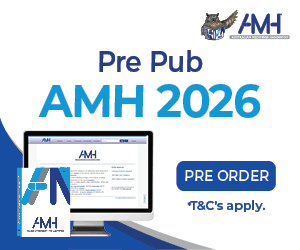The Australian Bureau of Statistics1 reports that in 2018 there were 219,000 Australians with dementia – of which 43% experienced chronic pain that may have been difficult to recognise and treat.
The incidence is high in this population due to comorbidities and age, whilst cognitive impairment may result in a reduced ability to report pain.2 When in pain, those with dementia may become aggressive or agitated, which are frequently misunderstood and inappropriately treated.2 Additionally, there is a lack of evidence and insufficient management guidelines.3
In this brief review, we aimed to investigate how pain is identified and managed. Methods included searching the contemporary peer-reviewed literature (2014-21) for original research published in English, including participants ≥ 65 years. An initial 532 papers were identified and reduced to 10 (quantitative and qualitative studies) when the full inclusion criteria were applied.
RESULTS
IDENTIFYING PAIN
Identifying pain in those with dementia is challenging4,5 and predominantly linked to patients’ inability to self-report.6
Family and careers are recognised as a key resource in identifying pain but may disengage when the patient is institutionalised.6 Nursing staff can identify some possible pain-related behaviours, eg. confusion and aggression, but admit that such behaviours need to be repeated before they are linked directly to pain.7
Staff experience and skill are therefore pivotal with a requirement to understand their patients, recognise behavioural cues, and develop trust.8
PAIN MANAGEMENT
Management of pain for those with dementia is challenging which includes refusal and administration difficulties – possibly due to an inability to recognise medication needs.9
This may lead to untreated pain and further agitation. Dysphagia is also common in late-stage dementia, restricting the use of oral analgesia, whilst advanced dementia leads to muscle wasting resulting in intramuscular injection challenges.9 Opioid use is also restricted due to physicians’ reluctance to prescribe them,10 whilst Nowak et al.2 identified that pain undertreatment is likely.
Further, others have identified that physicians avoid prescribing adequate analgesia due to the possibility of adverse events.7 The presence of disruptive behaviours can also lead to mistreatment of possible pain2 and where restraints are used leads to increased anxiety and pain.7 Nursing home residents with dementia and disruptive behaviours are treated with more sedatives than analgesics2 and mistreatment of pain with antipsychotics can increase the chance of delirium in persons with dementia, adding complexity to pain management.7,11
EDUCATION AND PATIENT ASSESSMENT
There is a call for consistent international guidelines for managing pain for those with dementia, including updated training regimes to enable staff to implement guidelines.2,7
A lack of education in this field is reported throughout (eg. ref 4,9,12) and may be dependent on the clinical speciality.8 For example, hospice nurses receive adequate education, but acute and aged care nurses receive little or none.9
Pain assessment questionnaires for those with dementia are available, eg. the Abbey Pain Scale13, but their validity and reliability are questionable. For example, the ability to distinguish between pain and distress 8, whilst assessment outcomes may be consistent with symptoms of depression.12 Peisah et al.8 therefore, recommends individualised pain assessments developed through the identification of unique pain-related behaviours. Nakashima et al.11 elaborate on this, suggesting that familiar carers should be recruited to determine each resident’s appropriate pain assessment and intervention.
CONCLUSION
Dementia patients are very likely to suffer untreated pain caused by communications issues involving patients, carers and clinicians. Undertreatment and mistreatment of pain are apparent, with improvements required in education and pain assessment methods. Pain management approaches must take into account the degree of cognitive decline and include multi-factorial approaches to enhance management. Consideration should be given to:
- Multi-professional education;
- Staffing adequacy;
- Family and carer involvement;
- Cross-disciplinary communication and collective staff interpretation of pain5 empowering staff and careers as “needs interpreters”;8
- Individualised pain assessment methods; and
- future research focussing on effective assessment and treatment procedures.12
References
-
Australian Bureau of Statistics (2020). Dementia in Australia. https://www.abs.gov.au/articles/dementia-australia
-
Nowak T, Neumann-Podczaska A, Deskir-Smielecka E, Styszynski A & Wieczorowska-Tobis K. Pain as a challenge in nursing home residents with behavioural and psychological symptoms of dementia. Clinical Interventions in Aging, 2018(13), 1045-1051. http://dx.doi.org/10.2147/CIA.S157246
-
Pain management in dementia. International Association for the Study of Pain (2019). https://www.apsoc.org.au/PDF/GYAP/2019_GYAP/Fact_Sheet_4_Pain_Management_in_Dementia_English_edited.pdf
-
De Witt Jansen B, Brazil K, Passmore P, Buchanan H, Maxwell D, Mcilfatrick SJ, Morgan SM, Watson M & Parsons C. ‘There’s a Catch-22′- The complexities of pain management for people with advanced dementia nearing the end of life: A qualitative exploration of physicians’ perspectives. Palliative Medicine, 2017. 31(8), 734-742. https://doi.org/10.1177/0269216316673549
-
Lichtner V, Dowding D, Allcock N, Keady J, Sampson EL, Briggs M, Corbett A, James K, Lasrado R, Swarbrick C & Closs SJ. The assessment and management on pain in patients with dementia in hospital settings: A multi-case exploratory study from a decision making perspective. BMC Health Services Research, 2016. 16(427). DOI 10.1186/s12913-016-1690-1
-
Minaya-Freire A, Ramon-Aribau A, Pou-Pujol G, Fajula-Bonet M & Subirana-Casacuberta M. Facilitators, barriers, and solutions in pain management for older adults with dementia. Pain Management Nursing, 21(2020), 495-501. https://doi.org/10.1016/j.pmn.2020.03.003
-
Rantala M, Kankkunen P, Kvist T & Hartikainen S. Barriers to postoperative pain management in hip fracture patients with dementia as evaluated by nursing staff. Pain Management Nursing, 2014. 15(1), 208-219. http://dx.doi.org/10.1016/j.pmn.2012.08.007
-
Peisah C, Weaver J, Wong L & Strukovski .A. Silent and suffering: a pilot study exploring gaps between theory and practice in pain management for people with severe dementia in residential aged care facilities. Clinical Interventions in Aging, 2014(9), 1767-1774. http://dx.doi.org/10.2147/CIA.S64598
-
De Witt Jansen B, Brazil K, Passmore P, Buchanan H, Maxwell, Mcilfatrick SJ, Morgan SM, Watson M & Parsons C. Nurses’ experiences of pain management for people with advanced dementia approaching the end of life: A qualitative study. Journal of Clinical Nursing, 2017. 26(9-10), 1234-1244. https://doi.org/10.1111/jocn.13442
-
Barry HE, Parsons C, Passmore AP & Hughes CM. Pain in care home residents with dementia: An exploration of frequency, prescribing and relatives’ perspectives. International Journal of Geriatric Psychiatry, 2015(30), 55-63. DOI: 10.1002/gps.4111
-
Nakashima T, Young Y & Hsu WH. Do nursing home residents with dementia receive pain interventions? American Journal of Alzheimer’s Disease & Other Dementias, 2019. 34(3), 193-198. DOI: 10.1177/1533317519840506
-
Thakur ER, Amspoker AB, Sansgiry S, Snow AL, Stanley M, Wilson N, Freshour J & Kunik ME. Pain among community-dwelling older adults with dementia: factors associated with undertreatment. Pain Medicine, 2017(18), 1476-1484. DOI: 10.1093/pm/pnw225
-
Australian Pain Society, Pain in residential aged care facilities: management strategies, 2nd Edition (2019) https://www.apsoc.org.au/PDF/Publications/APS_Pain-in-RACF-2_Abbey_Pain_Scale.pdf
Authors:
Tess Cooper is a student nurse, at the School of Health, Federation University, Churchill, Victoria.
Professor Simon Cooper (PhD) is at the School of Health, Federation University, Berwick, Victoria.








